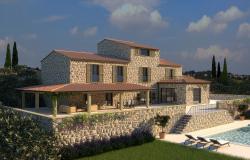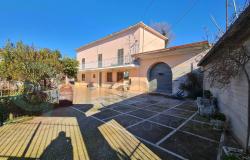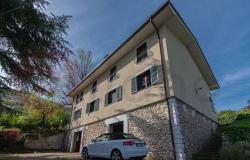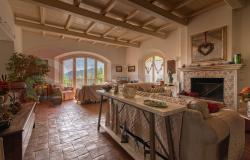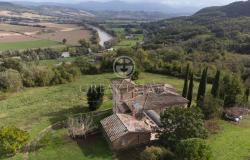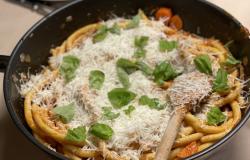Words by Miranda Goodman
Away from the maddening crowd there hides a beautiful corner of Italy. It’s called Sabina. A place of green hills covered in olive groves and dotted with old medieval villages, it has an incredible amount of secret gems to visit, wonderful genuine cooking, and religious and historical sites of interest - plus a famous DOP olive oil that simply must be tasted.
Sabina has very old roots - it partly provided the basis of ancient Roman culture, as some of Rome’s emperors, such as Tito Tazio, Numa Pompilio and Vespasian, were of Sabine origin.
I start my trail at Forum Novum, now known as Sanctuary of Vescovìo, where once an important Roman market town stood. Some of the excavations can be seen, brought to light by an English lady called Helen Patterson from the British School in Rome. Close to the ruins stands an atmospheric church, which was Sabina’s cathedral in the Middle Ages.
 From here I move on to Selci Sabino, a nearby village which likely gained its name from the paved stones (Silice) that can still be found in some parts of the old centre. It is a small borgo but has three churches, one of which has become part of a private property. Its biggest claim to fame, however is of a gastronomic bent - la porchetta, or roasted pig. Generations of families have made their fortune selling their ware at local markets and butcher shops. A good stop is the restaurant “La Vecchia Quercia” which serves traditional homemade cooking.
From here I move on to Selci Sabino, a nearby village which likely gained its name from the paved stones (Silice) that can still be found in some parts of the old centre. It is a small borgo but has three churches, one of which has become part of a private property. Its biggest claim to fame, however is of a gastronomic bent - la porchetta, or roasted pig. Generations of families have made their fortune selling their ware at local markets and butcher shops. A good stop is the restaurant “La Vecchia Quercia” which serves traditional homemade cooking.
 Close by, Torri in Sabina is the municipality of the area and has a characteristic old village centre. Just outside the village, two twin fortresses, Rocchette and Rocchettine, loom large over the countryside. Journeying around here is like stepping into a time warp, although it is hard to imagine that this peaceful area once was a busy commercial route linking Rieti to Rome.
Close by, Torri in Sabina is the municipality of the area and has a characteristic old village centre. Just outside the village, two twin fortresses, Rocchette and Rocchettine, loom large over the countryside. Journeying around here is like stepping into a time warp, although it is hard to imagine that this peaceful area once was a busy commercial route linking Rieti to Rome.
Further along at Cottanello stand the remains of a Roman Villa, which belonged to a rich and important noble family, the Cotta, who were part of the “gens Aurelia”—the very same who created one of Rome’s most important roads, the Aurelian way. Rose coloured marble was excavated in this area and used for some of the columns in St Peter’s Church in Rome.
 Travelling through the valley, I pass by Cantalupo in Sabina which has a grand palace, Palazzo Camuccini, standing lavish and elegant at the end of the main street. Mario Verdone, the late father of a famous Italian actor, lived in this village and sung its beauty and the charm of the Sabina landscape in a book that has just recently been released.
Travelling through the valley, I pass by Cantalupo in Sabina which has a grand palace, Palazzo Camuccini, standing lavish and elegant at the end of the main street. Mario Verdone, the late father of a famous Italian actor, lived in this village and sung its beauty and the charm of the Sabina landscape in a book that has just recently been released.
Eight minutes’ drive away, the hilltop town of Casperia earned the prestigious Orange Flag, or Bandiera Arancione, from the Italian Touring Club for the authenticity and preservation of its ancient centre, where cars are not allowed. Winding cobbled streets overlook magnificent views and often capture spectacular sunsets. This is a great place for wine and olive oil tastings and it is possible to visit a local olive mill.
Driving along the winding road I come to Roccantica. In keeping with its name, it has old castle walls, an ancient tower and medieval origins, which it celebrates every August with a fantastic festival in period costume. Everybody in the village participates in the event and Grammy Award Rhonda Larson comes every year to join in the celebrations.
The last stop on the trail is Poggio Mirteto, a town with many fascinating churches, and the ruins of some Roman Baths (Lucilla). Legend has it that Garibaldi stopped here with his wife and in his memory a bronze bust is displayed. The local band takes his name and dresses in his typical uniform to commemorate a group that lost their lives in the battle of Mentana.
Poggio Mirteto is also known in the area for its crazy Carnival, an irreverent and transgressive event with colourful floats, masks, dancing and the burning of an effigy. Oh and for a wine producer, Cantina Santa Lucia, which has won a coveted Slow Food Award for the quality of its wine.
How to get to Sabina
Motorway A1 Rome/Florence – exit Ponzano Romano/Soratte.


